Traditional Japanese Fly Kabari 2 |
 |
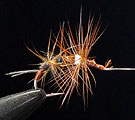 |
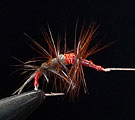 |
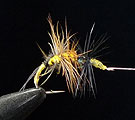 |
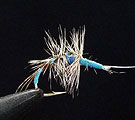 |
|||
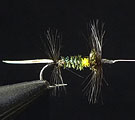 |
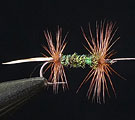 |
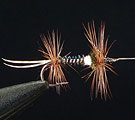 |
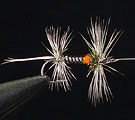 |
|||
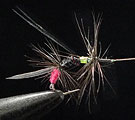 |
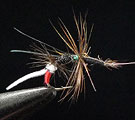 |
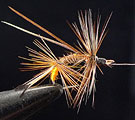 |
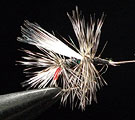 |
|||
Mutsu Morioka area
Traditional flies in Morioka Iwate Prefecture.
It is called Morioka kebari or Nanbu kabari.
Now, we can get those flies as traditional craft work that is kept by craftsmen.
It is said that it was made by modifying the fishing method called "Ippon Kebari (One Fly)" which uses a taper line of horse tail at the 1920s.
Those flies are like Tenkara but the rig is unique.
It is generally used 5.4m (18ft.) rod.
It has line and leader as long as rod, float that is made of angelica tree at the tip of the leader, fly that has 40cm (16in.) tippet in front of the float,
and four flies that has very short tippet are tied at intervals of 30 or 40cm (12-16in.) above the float.
After casting to the other side, it float flies down a river with line tight.
It is called "Nagashi-tsuri".
The flies of upper row were tied by Mr. Zenji Sakurai.
The flies of middle row are Mr. Yuzo Yanagimura's kebari that were published in "Fishing Cafe vol. 23".
These are flies that I replicated.
The hook called "Kukinaga 8 ban (Long stem No. 8)" that has total length of 1.5 cm, and kirby point has been used,
but we cannot get the hook currently because there are no craftsmen to be able to make it.
I have twisted and used Maru-kaizu No. 8 of MARUTO very similar in form.
The lower row are the flies that were tied by Mr. Hiroshi Ishizawa who was chosen to the Contemporary Master Craftsman as successor of the traditional Morioka Rod and Morioka Kebari and was also awarded the Yellow Ribbon Medal.
The kebari tied by Mr. Hiroshi Ishizawa has antennas or wings attached, it has a different shape from the conventional Morioka Kebari.
Moreover, Kebari for Tenkara fishing and Fly fishing were also tied.
Morioka kebari is characterized by double hackles, but kebari with a single hackle also exists.References: Murata, H. (2006). Morioka kebari. Fishing Cafe, 23, Osaka: Shimano. Murata, S. (1988). Nanbu no Tsuri Morioka kebari [Fishing in southern part Morioka kebari]. Yukyo Iwate no Tsuri [Quiet place Fishing of Iwate]. Tokyo: Yama-kei Publishers. Suzuno, F. (1993). Yamaryou [Mountain fishing]. Tokyo: Rural Culture Association. Morioka Chiisana Hakubutsukan [Morioka Small Museum]. (March 2018 Pamphlet), Morioka City Industry Festival Executive Committee. |
||||||
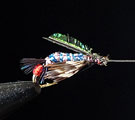 |
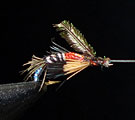 |
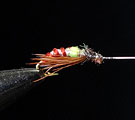 |
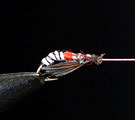 |
|||
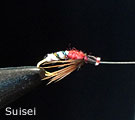 |
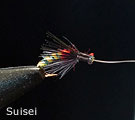 |
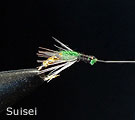 |
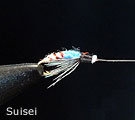 |
|||
Higashishinano Ueda area
Sanada kebari with different taste from other kabari.
They have gaudy colors and look like a nymph pattern of western style fly and, are also a strange shaped kebari that were attached one peacock herl to the position of wing.
The body was tied by silk thread and pheasant and ducks, the hackle was Nagoya cochin or bantams, hook was Akita-kitsune No. 4-7 (Western hook size #20-13).
It is a "Nagashi-tsuri" with 5-9 kebari and a wooden float at the tip.
The kebari of photos were made by Sanada kebari that has a history of more than 100 years in Ueda, Nagano.
On the package of rig there is an indication "Registered Trademark Sanada-kebari Master's Handmade Rig Carefully Made by Tsuchicho".
In the Edo Period at peace, fishing became a boom among samurai, and various fishing such as black porgy fishing and goby fishing were done in various places.
Kaga kebari, Tosa kebari and Banshu kebari originated in each castle town because Ayu fishing is popular in the freshwater area.
It is said that Sanada kebari was also devised for fishing Ugii (Japanese dace) and Oikawa (Pale chub) at Matsushiro castle town and has been handed down.
The hook size of upper row are large and those seems that were also used for fishing Yamame and Iwana.
The hook size of lower row are small and are named "Suisei (Mercury)".
Those seems that were mainly used for fishing Ugii and Oikawa.References: Takumi no waza Sanada-kebari [Craftsmanship Sanada-kebari]. Shukan Nippon Kawa Kiko Shinshu Chikumagawa. (First issue 2004), Tokyo: GAKKEN. |
||||||
Flies |
Equipment |
| Back to Main Home Page | Profile | Links |
Home |
Paper Craft of Japanese Trout and the World Trout © 1997 Yoshikazu Fujioka |